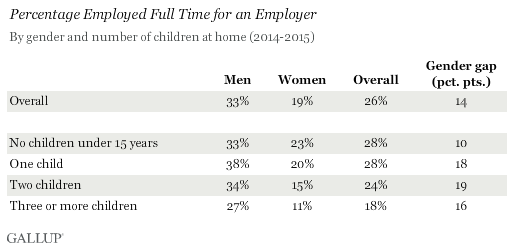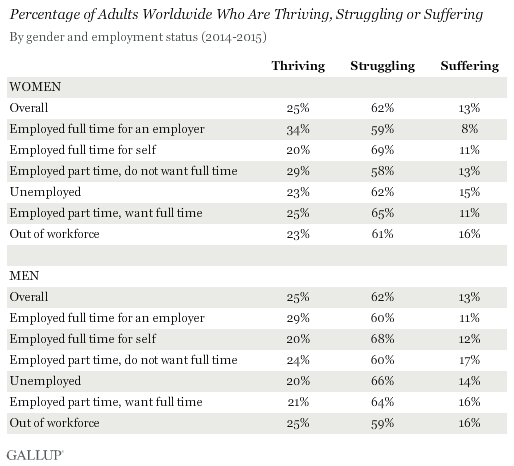Women's Life Ratings Get Better With Full-Time Jobs
Thursday, March 31st, 2016
Worldwide, men (33%) are more likely than women (19%) to have a full-time job for an employer. Having children younger than age 15 living in the household heightens this gender gap, and the more children living at home, the fewer the women working full time for an employer. Further, women are most likely to rate their lives positively enough to be considered "thriving" when they are working full time for an employer and most likely to rate their lives poorly enough to be considered "suffering" when they are out of the workforce.
"Women seeking paid work are often effectively penalized because they carry a disproportionate share of care responsibilities in the home. Family-supportive policies are key to gender equality," said Guy Ryder, the director-general of the International Labour Organization. "They underpin the well-being of societies, are a factor of productivity and protect future workforces."

In line with ILO's standard definition of unemployment, Gallup's reported unemployment rate represents the percentage of adults in the workforce who did not have any paid work in the past seven days, either for an employer or themselves, and who were actively looking for and available to work. The workforce consists of all adults who are either working -- whether full or part time -- or are unemployed. Worldwide, women are much more likely than men to be out of the workforce, largely reflecting a combination of social traditions and pressure for women to be homemakers rather than breadwinners.
Gallup research shows that the benefits of full-time jobs for an employer extend beyond providing a simple paycheck. This piece represents Gallup's initial contribution to the ILO's Women at Work Centenary Initiative on the needs and aspirations of working women worldwide, which aims to bring fresh insights and explore interesting findings that warrant further analysis. Gallup and ILO will launch a joint report on International Women's Day in March 2017.
More Children at Home Leads to Fewer Women Working Full Time
In recent years, Gallup has asked people worldwide how many children younger than age 15 are living in their households, regardless of whose children they are. This measure is a useful proxy for the effect that having children in the home has on men's and women's propensity to work full time for an employer. In fact, men are more likely to be working full time and women are less likely to be working full time in households with one or two children when compared with households with no children under age 15.

For women, the effect of having children younger than age 15 at home and employment status varies significantly from region to region -- particularly among those in their prime working years (age 25 to 54). The strength of the effect of having more children in the home varies greatly as well. Before age 25 and after age 54, women are much more likely to have no children younger than 15 in their home compared with the average for women of all ages. They are also much less likely to be working full time, but not because of the number of children younger than age 15 present in the home.

Having more children under the age of 15 in the home most dramatically affects women's employment in Australia and New Zealand, the Levant (Lebanon, Syria, Iraq, Jordan and the Palestinian Territories), as well as the Commonwealth of Independent States countries (excluding Russia), East Asia, and North Africa and Yemen. In these regions, women who live with three or more children younger than age 15 are less than half as likely to be working full time as are women who live with none. Conversely, in any area of Europe, Northern America or Latin America, two-thirds as many women who live with three or more children work full time compared with women who live with none.
The Effect of Women's Employment on Their Life Evaluations
Many women worldwide choose to stay at home to take care of family members and the home instead of entering gainful employment or professional careers. Yet many women might make a different choice if they were given the opportunity to work outside the home.
Despite being much more likely to be out of the workforce, women, like men, are most likely to be considered thriving when they are working full time for an employer. In addition, women are also most likely to be considered suffering when they are out of the workforce. Gallup classifies people as "thriving," "struggling" or "suffering" according to how they rate their current and future lives on a ladder scale with steps numbered from 0 to 10 based on the Cantril Self-Anchoring Striving Scale. People are considered thriving if they rate their current lives a 7 or higher and their lives in five years an 8 or higher and suffering if they rate both their current and future life situations a 4 or lower. Those in the middle are considered "struggling," and most people around the world fall into this category.

Conclusion
Women's employment worldwide has consistently lagged behind men's employment for many reasons, not least because of social traditions and pressure for women to care for children at home. The effect of these traditions and societal pressure varies significantly from region to region, as do the underlying economic and policy environments that encourage or discourage women's participation in the workforce.
It is no accident that women are more likely to be employed full time for an employer in more economically developed regions, regardless of underlying traditions about gender. When large portions of the population are strongly encouraged to refrain from paid employment in favor of unpaid care and household work, this limits the size and dynamism of the economy. In addition, beyond the economic implications, women's lower rates of full-time employment would appear to negatively affect how they evaluate their lives now and in the future.
"These findings highlight the importance of good jobs, especially for women, in creating lives well-lived," said Jon Clifton, managing partner at Gallup. Finding ways to accommodate the aspirations of both men and women economically, as well as the needs of the home, remains a challenge in every region of the world today.


